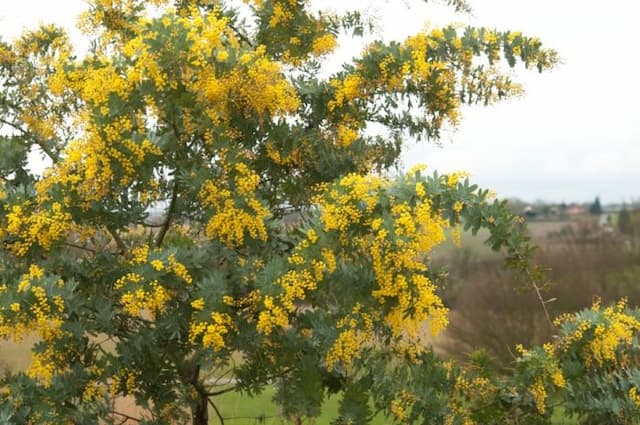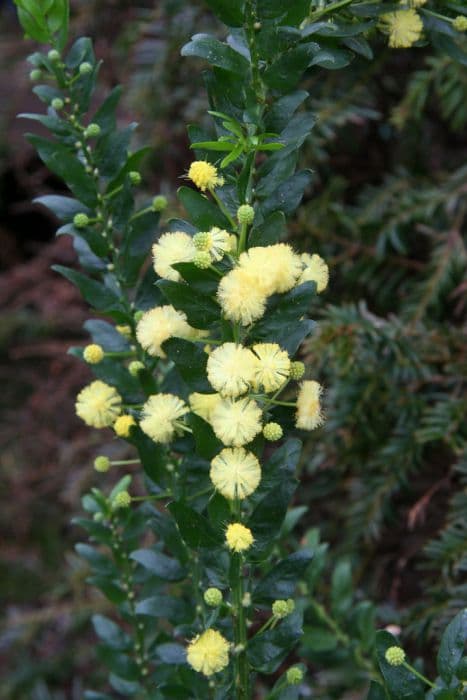Pea Pisum sativum 'Delikett'

ABOUT
The pea plant known as 'Delikett' is a popular variety grown for its tender and flavorful pods. This plant typically displays a lovely green hue with climbing or trailing vines that bear multiple leaves. The leaves themselves are composed of pairs of leaflets, which are small and oval, with a tendril at the tip, allowing the plant to grasp onto supports as it climbs. The flowers found on the 'Delikett' variety are usually white and unassuming, serving the primary purpose of being pollinated and then developing into the edible pea pods. The pods are smooth and plump, with a vibrant green color, and encase the round, sweet peas inside. These peas are typically a bright green color, suggesting freshness and a readiness to be picked for culinary use. Overall, the 'Delikett' pea plant presents as a healthy, bushy vegetable plant that is characterized by its delightful pods which are perfect for garden-to-table dishes, offering both visual appeal in the garden and taste appeal in the kitchen.
About this plant
 Names
NamesFamily
Fabaceae.
Synonyms
Pea, Green Pea, Garden Pea, English Pea, Snap Pea.
Common names
Pisum sativum 'Delikett'.
 Toxicity
ToxicityTo humans
Pea 'Delikett', a variety of garden pea, is not considered toxic to humans when consumed. Peas, including the 'Delikett' cultivar, are commonly eaten around the world as a food source. However, it's important to note that consuming peas that have not been properly prepared or consuming large quantities of raw pea seeds may cause digestive issues due to the presence of natural substances like lectins and saponins found in many legumes. Typically, these substances can cause gas, bloating, and stomach cramps; however, normal culinary preparation methods usually render the peas safe for consumption.
To pets
Pea 'Delikett' is also not considered toxic to pets. Both dogs and cats can eat peas in moderation as part of a balanced diet. They should be cooked without added salt or seasonings, as some added ingredients can be harmful to pets. However, similar to humans, feeding large amounts of raw peas to pets could lead to gastrointestinal upset due to the same naturally occurring substances such as lectins and saponins. Cooked peas in small amounts can be a healthy treat for pets, but as with any new food, it should be introduced slowly to their diet to ensure they tolerate it well.
 Characteristics
CharacteristicsLife cycle
Annuals
Foliage type
Deciduous
Color of leaves
Green
Flower color
White
Height
2-3 feet (0.6-0.9 meters)
Spread
1-2 feet (0.3-0.6 meters)
Plant type
Herb
Hardiness zones
2-11
Native area
Mediterranean
Benefits
 General Benefits
General Benefits- Edible Pods: Pisum sativum 'Delikett', commonly known as the snap pea, produces edible pods that are sweet and crunchy, often eaten raw or cooked.
- High Nutrient Content: Snap peas are rich in vitamins, particularly Vitamin C, and also provide folate, Vitamin K, and fiber.
- Nitrogen Fixation: As a legume, snap peas contribute to soil fertility by fixing atmospheric nitrogen into the soil, benefiting other plants in the garden.
- Easy to Grow: Snap peas are relatively easy to cultivate and can thrive in a range of climates, making them accessible to many gardeners.
- Climbing Plant: With their climbing habit, they can be grown vertically, which saves space and can be used for ornamental purposes to create green walls.
- Attracts Pollinators: The flowers of the snap pea plant can attract beneficial insects such as bees, which are important for pollination.
- Early Harvest: Snap peas typically have a short time to maturity, allowing for an early harvest in the growing season.
- Companion Planting: They grow well with many other vegetables and herbs, making them ideal for companion planting which can aid in pest control and space utilization.
- Continuous Harvest: Once the harvest begins, snap peas often continue producing pods over an extended period if pods are regularly picked.
- Culinary Versatility: Snap peas are versatile in the kitchen, suitable for a wide range of dishes including salads, stir-fries, and as healthy snacks.
 Medical Properties
Medical PropertiesThis plant is not used for medical purposes.
 Air-purifying Qualities
Air-purifying QualitiesThis plant is not specifically known for air purifying qualities.
 Other Uses
Other Uses- Pisum sativum 'Delikett', commonly known as pea, can be used as a natural dye for fabrics, giving a soft green color when the pods are boiled and the fabric is dipped.
- Pea vines can be fashioned into natural wreaths and decorations after the peas have been harvested, offering a rustic look for interior design or special events.
- Dried peas can be utilized as a filler for bean bags or as a natural, biodegradable stuffing material for toys and pillows.
- Leftover pea pods can be used as compost or mulch in gardens to enrich the soil and help maintain moisture levels in the ground.
- Pea straw, the dried vines after harvest, is often used as livestock fodder, particularly for sheep, providing a source of nutrition during the winter months.
- The hollow stems of pea plants can be used as natural straws or for crafting small-scale plant stakes or supports for other garden plants.
- Whole pea plants can be incorporated into garden beds as a green manure, tilled under to increase nitrogen content and improve soil structure.
- Crushed dried peas can serve as an organic, biodegradable abrasive material for cleaning or sandblasting.
- Pea tendrils, the young shoot tips, can be used in floral arrangements for their delicate texture and curling shape.
- Fresh or dried peas can be utilized in educational activities, such as counting games for children or studies in plant biology.
Interesting Facts
 Feng Shui
Feng ShuiThe plant Pisum sativum, commonly known as pea, is not used in Feng Shui practice.
 Zodiac Sign Compitability
Zodiac Sign CompitabilityThe plant Pisum sativum, commonly known as pea, is not used in astrology practice.
 Plant Symbolism
Plant Symbolism- Prosperity and Wealth: The pods of the pea plant, which hold multiple peas, are seen as symbolic of abundance and the promise of future prosperity.
- New Beginnings and Growth: As peas are often among the first crops to be planted and harvested in the springtime, they represent new opportunities and growth.
- Nurturance and Care: The way pea plants need support as they grow, such as trellises, symbolizes the importance of nurturing and caring relationships.
- Celebration of Youth: The green color and tender nature of peas are often associated with youthfulness and the joy of life.
- Resilience and Adaptability: Being a hardy crop that can thrive in a variety of conditions, the pea plant represents resilience and the ability to adapt to life’s challenges.
 Water
WaterWater snap peas (Pisum sativum 'Delikett') thoroughly once a week with approximately 1 inch (0.623 gallons) of water. During periods of drought or particularly hot weather, you may need to water twice a week. Ensure the soil is moist but not waterlogged, as snap peas prefer well-drained soil. It's best to water the plant at the base to avoid wetting the foliage, which can lead to fungal diseases. Reduce watering once the pods begin to mature, as too much moisture can cause the pods to split.
 Light
LightSnap peas, including the 'Delikett' variety, thrive in full sunlight, which means they require at least 6 to 8 hours of direct sunlight each day. They can tolerate partial shade but may not produce as abundantly. For best growth, plant your snap peas in a spot that gets plenty of morning sun and some afternoon shade, especially in regions with hot summers.
 Temperature
TemperatureSnap peas like 'Delikett' prefer a cooler climate and grow best when daytime temperatures are around 60 to 75 degrees Fahrenheit. They can survive occasional temperatures down to 20 degrees Fahrenheit and up to 85 degrees Fahrenheit but will not produce well outside this range. Planting should occur as soon as the soil can be worked in spring, typically when soil temperatures are above 45 degrees Fahrenheit.
 Pruning
PruningPruning is generally not necessary for snap peas like 'Delikett', as they are a determinate plant and will stop growing on their own once they reach their full height. However, removing damaged or diseased vines can help improve air circulation and prevent the spread of fungal diseases. The best time for any required pruning is when the vines are dry, to minimize the risk of spreading disease.
 Cleaning
CleaningAs needed
 Soil
SoilPeas (Pisum sativum 'Delikett') thrive in well-drained, loamy soil with a pH between 6.0 and 7.5. A mixture of garden soil, compost, and perlite or vermiculite can provide the ideal conditions for root growth and health.
 Repotting
RepottingPeas, such as 'Delikett', are typically not repotted as they are annual plants. Instead, they should be sown directly into the garden each year or started in biodegradable pots to transplant.
 Humidity & Misting
Humidity & MistingPeas, commonly referred to as 'Delikett', prefer moderate humidity levels but are adaptable to various conditions and do not require specific humidity adjustments.
 Suitable locations
Suitable locationsIndoor
Grow 'Delikett' peas in deep pots, with ample light.
Outdoor
Sow 'Delikett' peas in full sun, cool season, in fertile soil.
Hardiness zone
Peas (Pisum sativum 'Delikett') are suitable for 3-8 USDA hardiness zones.
 Life cycle
Life cyclePisum sativum 'Delikett', commonly known as the sugar snap pea, begins its life as a seed, typically planted in early spring once the soil is workable and the risk of frost has passed. Germination occurs within 7 to 14 days, after which the seedlings emerge and soon develop true leaves and a vine structure that may require support for optimal growth. The plant's flowers blossom approximately 40 to 60 days after planting, featuring small, white blooms that are self-pollinating, which leads to the development of edible pea pods. The pods mature in about 60 to 70 days from sowing, reaching a stage where they can be harvested, usually when they are plump but the peas inside are still immature. After harvesting, the plant will continue to produce more flowers and pods until the weather becomes too hot or until the plant exhausts its productive lifespan. At the end of the growing season, the plant's foliage will yellow and wither, completing its annual life cycle, and if pods are left to fully mature on the plant, they can be collected for seeds to grow in the following season.
 Propogation
PropogationPropogation time
Spring to early summer
The common name for Pisum sativum 'Delikett' is snap pea. The most popular method of propagation for snap peas is by direct sowing of seeds into the garden. This is typically done in early spring as soon as the soil can be worked and there is no risk of a hard frost, when soil temperatures reach around 45°F (7°C). To sow snap pea seeds, you should plant them 1 to 1.5 inches (2.5 to 3.8 cm) deep, spacing them about 2 to 3 inches (5 to 7.6 cm) apart in rows. The rows should be spaced approximately 18 to 24 inches (45 to 61 cm) apart. Snap peas prefer full sun and well-drained soil. They generally begin to germinate within 7 to 14 days, and it's important to keep the soil consistently moist during this period.









